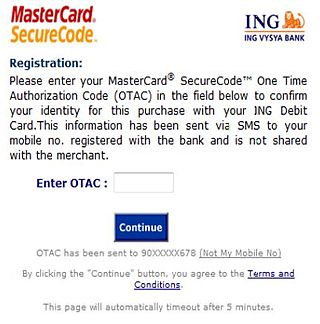
Kerberos is a computer-network authentication protocol that works on the basis of tickets to allow nodes communicating over a non-secure network to prove their identity to one another in a secure manner. Its designers aimed it primarily at a client–server model, and it provides mutual authentication—both the user and the server verify each other's identity. Kerberos protocol messages are protected against eavesdropping and replay attacks.

A password, sometimes called a passcode, is secret data, typically a string of characters, usually used to confirm a user's identity. Traditionally, passwords were expected to be memorized, but the large number of password-protected services that a typical individual accesses can make memorization of unique passwords for each service impractical. Using the terminology of the NIST Digital Identity Guidelines, the secret is held by a party called the claimant while the party verifying the identity of the claimant is called the verifier. When the claimant successfully demonstrates knowledge of the password to the verifier through an established authentication protocol, the verifier is able to infer the claimant's identity.
A key in cryptography is a piece of information, usually a string of numbers or letters that are stored in a file, which, when processed through a cryptographic algorithm, can encode or decode cryptographic data. Based on the used method, the key can be different sizes and varieties, but in all cases, the strength of the encryption relies on the security of the key being maintained. A key's security strength is dependent on its algorithm, the size of the key, the generation of the key, and the process of key exchange.
In computing, the Challenge-Handshake Authentication Protocol (CHAP) is an authentication protocol originally used by Point-to-Point Protocol (PPP) to validate users. CHAP is also carried in other authentication protocols such as RADIUS and Diameter.
In cryptography and computer security, a man-in-the-middle (MITM) attack, or on-path attack, is a cyberattack where the attacker secretly relays and possibly alters the communications between two parties who believe that they are directly communicating with each other, where in actuality the attacker has inserted themselves between the two user parties.

In cryptography, a block cipher mode of operation is an algorithm that uses a block cipher to provide information security such as confidentiality or authenticity. A block cipher by itself is only suitable for the secure cryptographic transformation of one fixed-length group of bits called a block. A mode of operation describes how to repeatedly apply a cipher's single-block operation to securely transform amounts of data larger than a block.
Transport Layer Security (TLS) is a cryptographic protocol designed to provide communications security over a computer network, such as the Internet. The protocol is widely used in applications such as email, instant messaging, and voice over IP, but its use in securing HTTPS remains the most publicly visible.
A replay attack is a form of network attack in which valid data transmission is maliciously or fraudulently repeated or delayed. This is carried out either by the originator or by an adversary who intercepts the data and re-transmits it, possibly as part of a spoofing attack by IP packet substitution. This is one of the lower-tier versions of a man-in-the-middle attack. Replay attacks are usually passive in nature.
The Encrypting File System (EFS) on Microsoft Windows is a feature introduced in version 3.0 of NTFS that provides filesystem-level encryption. The technology enables files to be transparently encrypted to protect confidential data from attackers with physical access to the computer.
S/KEY is a one-time password system developed for authentication to Unix-like operating systems, especially from dumb terminals or untrusted public computers on which one does not want to type a long-term password. A user's real password is combined in an offline device with a short set of characters and a decrementing counter to form a single-use password. Because each password is only used once, they are useless to password sniffers.
IEEE 802.11i-2004, or 802.11i for short, is an amendment to the original IEEE 802.11, implemented as Wi-Fi Protected Access II (WPA2). The draft standard was ratified on 24 June 2004. This standard specifies security mechanisms for wireless networks, replacing the short Authentication and privacy clause of the original standard with a detailed Security clause. In the process, the amendment deprecated broken Wired Equivalent Privacy (WEP), while it was later incorporated into the published IEEE 802.11-2007 standard.

A one-time password (OTP), also known as a one-time PIN, one-time passcode, one-time authorization code (OTAC) or dynamic password, is a password that is valid for only one login session or transaction, on a computer system or other digital device. OTPs avoid several shortcomings that are associated with traditional (static) password-based authentication; a number of implementations also incorporate two-factor authentication by ensuring that the one-time password requires access to something a person has as well as something a person knows.
The Secure Remote Password protocol (SRP) is an augmented password-authenticated key exchange (PAKE) protocol, specifically designed to work around existing patents.

Digest access authentication is one of the agreed-upon methods a web server can use to negotiate credentials, such as username or password, with a user's web browser. This can be used to confirm the identity of a user before sending sensitive information, such as online banking transaction history. It applies a hash function to the username and password before sending them over the network. In contrast, basic access authentication uses the easily reversible Base64 encoding instead of hashing, making it non-secure unless used in conjunction with TLS.
In cryptography, CRAM-MD5 is a challenge–response authentication mechanism (CRAM) based on the HMAC-MD5 algorithm. As one of the mechanisms supported by the Simple Authentication and Security Layer (SASL), it is often used in email software as part of SMTP Authentication and for the authentication of POP and IMAP users, as well as in applications implementing LDAP, XMPP, BEEP, and other protocols.
In a Windows network, NT LAN Manager (NTLM) is a suite of Microsoft security protocols intended to provide authentication, integrity, and confidentiality to users. NTLM is the successor to the authentication protocol in Microsoft LAN Manager (LANMAN), an older Microsoft product. The NTLM protocol suite is implemented in a Security Support Provider, which combines the LAN Manager authentication protocol, NTLMv1, NTLMv2 and NTLM2 Session protocols in a single package. Whether these protocols are used or can be used on a system, which is governed by Group Policy settings, for which different versions of Windows have different default settings.

In cryptography, a nonce is an arbitrary number that can be used just once in a cryptographic communication. It is often a random or pseudo-random number issued in an authentication protocol to ensure that each communication session is unique, and therefore that old communications cannot be reused in replay attacks. Nonces can also be useful as initialization vectors and in cryptographic hash functions.
OTPW is a one-time password system developed for authentication in Unix-like operating systems by Markus Kuhn. A user's real password is not directly transmitted across the network. Rather, a series of one-time passwords is created from a short set of characters and a set of one-time tokens. As each single-use password can only be used once, passwords intercepted by a password sniffer or key logger are not useful to an attacker.
In cryptography, the Salted Challenge Response Authentication Mechanism (SCRAM) is a family of modern, password-based challenge–response authentication mechanisms providing authentication of a user to a server. As it is specified for Simple Authentication and Security Layer (SASL), it can be used for password-based logins to services like LDAP, HTTP, SMTP, POP3, IMAP and JMAP (e-mail), XMPP (chat), or MongoDB and PostgreSQL (databases). For XMPP, supporting it is mandatory.
An oblivious pseudorandom function (OPRF) is a cryptographic function, similar to a keyed-hash function, but with the distinction that in an OPRF two parties cooperate to securely compute a pseudorandom function (PRF).





